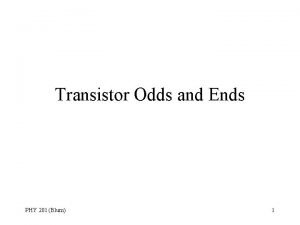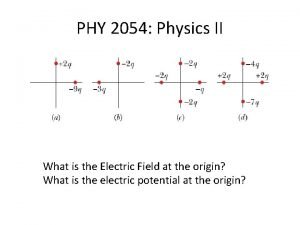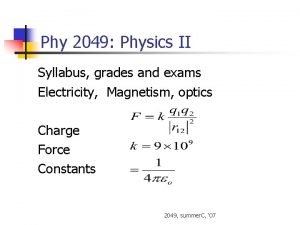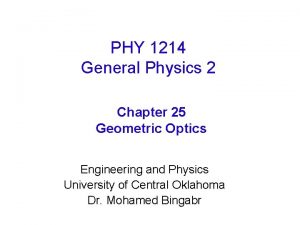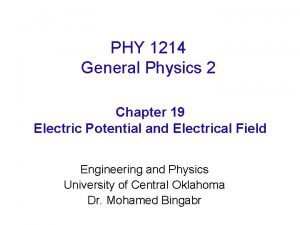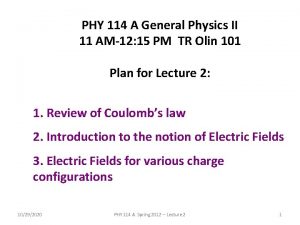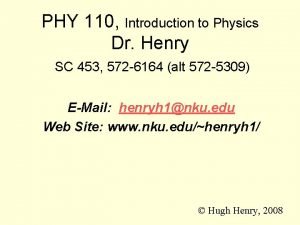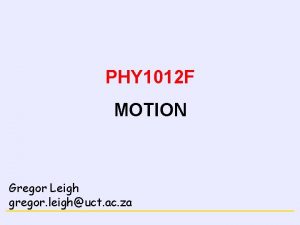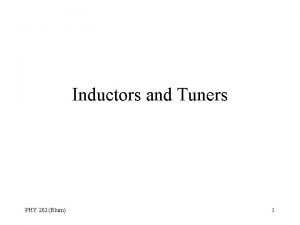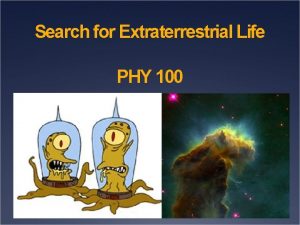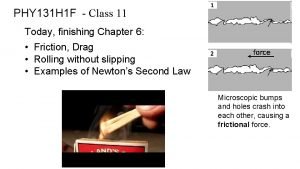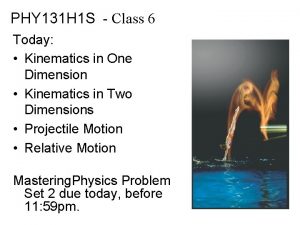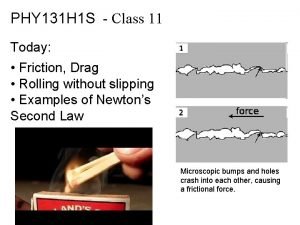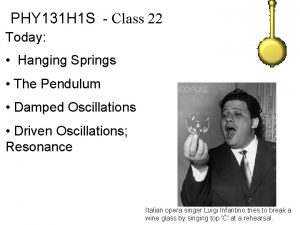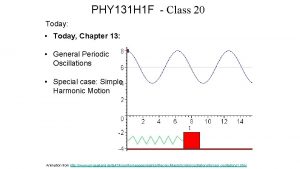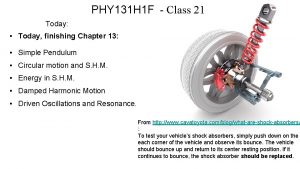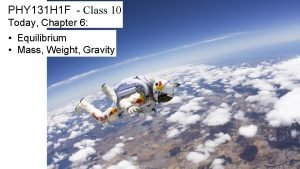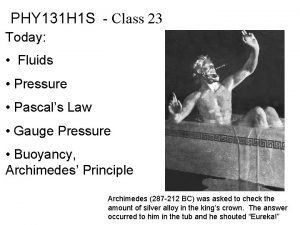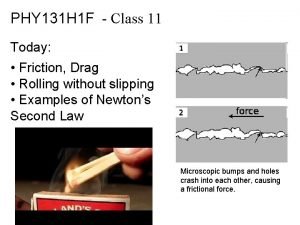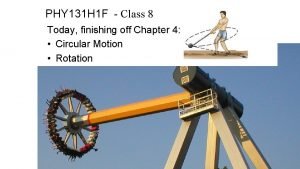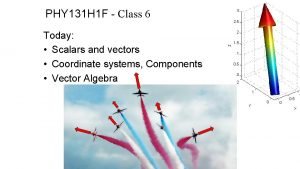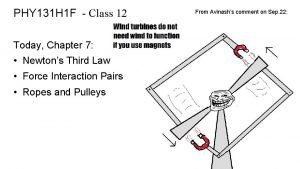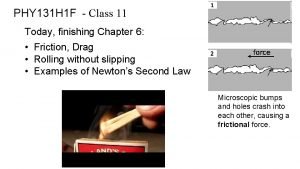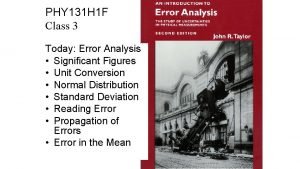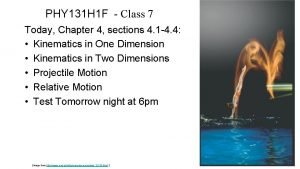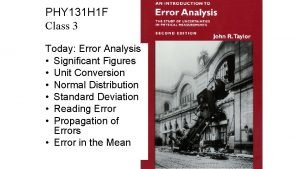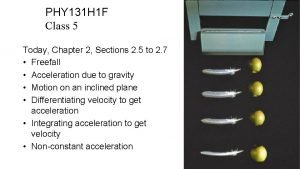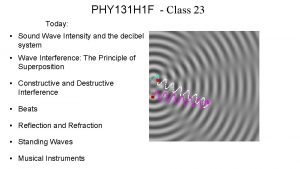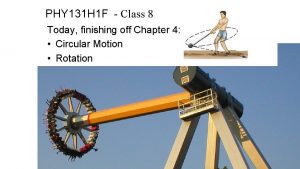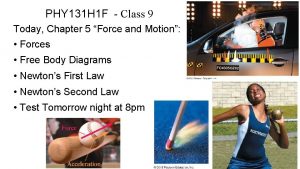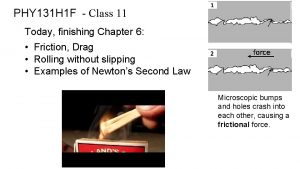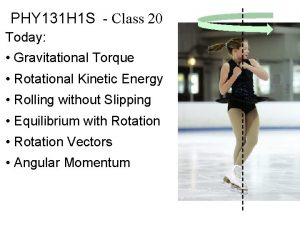Today PHY 131 H 1 F Class 24





























- Slides: 29

Today: PHY 131 H 1 F - Class 24 The last class!! • Finishing Ch. 14 up to section 14. 7: • Course review • Standing Sound Waves • Tips for the final exam • Wind Instruments

Reading Question 21. 5 Discussion Question Learning Catalytics The frequency of the third harmonic of a string is A. B. C. D. One-third the frequency of the fundamental. Equal to the frequency of the fundamental. Three times the frequency of the fundamental. Nine times the frequency of the fundamental.

Standing Sound Waves • A long, narrow column of air, such as the air in a tube or pipe, can support a longitudinal standing sound wave. • A closed end of a column of air must be a displacement node. Thus the boundary conditions — nodes at the ends — are the same as for a standing wave on a string. • It is often useful to think of sound as a pressure wave rather than a displacement wave. The pressure oscillates around its equilibrium value. • The nodes and antinodes of the pressure wave are interchanged with those of the displacement wave.

Standing Sound Waves

Standing Sound Waves

§ Displacement x and pressure graphs for the m = 2 mode of standing sound waves in a closed-closed tube. § The nodes and antinodes of the pressure wave are interchanged with those of the displacement wave.

Quick. Check 21. 6 Learning Catalytics Discussion Question An open-open tube of air has length L. Which is the displacement graph of the m = 3 standing wave in this tube?


Preclass question from yesterday morning

Example from a past test A metal pipe, open at both ends, can create a standing wave in the second harmonic with a frequency of 483 Hz. What is the length of the pipe?



Quick. Check 21. 7 Learning Catalytics Discussion Question An open-closed tube of air of length L has the closed end on the right. Which is the displacement graph of the m = 3 standing wave in this tube?


Musical Instruments § With a wind instrument, blowing into the mouthpiece creates a standing sound wave inside a tube of air. § The player changes the notes by using her fingers to cover holes or open valves, changing the length of the tube and thus its fundamental frequency: for an open-open tube instrument, such as a flute for an open-closed tube instrument, such as a clarinet § In both of these equations, v is the speed of sound in the air inside the tube. § Overblowing wind instruments can sometimes produce higher harmonics such as f 2 2 f 1 and f 3 3 f 1.

Review: Gravitational Potential Energy • The correct, general equation for the gravitational potential energy of a system consisting of two masses M and m a distance r apart is: • Where the zero point is arbitrarily set so that U = 0 when r = ∞. • Consider an object of mass m, a small distance h above the surface of a planet of mass M and radius R. Let’s do a Taylor Expansion of U(h):

Review: Conservation of Mechanical Energy K 1 = 0 U 1 = 10, 000 J K 2 = 2, 500 J U 2 = 7, 500 J K 3 = 7, 500 J U 3 = 2, 500 J K 4 = 10, 000 J U 4 = 0

Review: Angular Acceleration • Angular acceleration is the rate of change of angular velocity.

Review: Torque • The equation for Torque is

Review: Rotational Inertia • For a system of discrete masses, the rotational inertia is the sum of the rotational inertias of the individual masses: Newton’s Second Law for Rotation:

The last thing in PHY 131 you have to do: The Final Exam • EX is Central Exams Facility, 255 Mc. Caul St. (just south of College St. )

What to expect § 2 hours. § 12 multiple choice questions worth 2 points each (24 points total) § 3 long-answer problems worth 6 points each for which you must show your work (18 points total). § Final exam is out of 42 points. § Expect an even spread of material over the entire course: Chs. 1 -14.

Suggested Study Plan 1. Review reading and lecture notes and Practicals Activities for the entire course. 2. Work through the Mastering. Physics Homeworks 1 -11. Make sure you can do these problems on paper. 3. Work through all suggested end-of-chapter exercises, and then problems. 4. Work through all the Practice Problems from the first hours of Practicals. 5. After you have done the above, if you have time, try some past exams or past midterms.

Study Groups – working with Peers • Find student (students) in class that you work well with on Mastering. Physics, end-ofchapter suggested problems, and past tests. • The best way to learn is to teach! If you can’t explain to someone else what you have done, you haven’t really understood it! (This is harder than you think!)

Past Tests and Exams • The purpose of obtaining and going through old tests and exams is to get to know “the system”. • Each course and prof will have a certain pattern and style. Knowing the pattern in advance gives you an edge. • Don’t count on lightning to strike twice – memorizing old test questions rarely works!

Aids Allowed on the Final Exam • Any calculator without communication capability. • Aid sheet: one single, original, handwritten 8 1/2 × 11 inch sheet of paper, which may be written on both sides. • A ruler. • A paper copy of an English translation dictionary. • Also:

During the Exam • Exam begins at 9: 00 am SHARP!!! Seating will begin at 8: 50 am, pens hit paper at 9: 00. • This exam is run by the faculty, not the physics department, so be extra careful about the rules. • Skim over the entire exam front to back before you begin. Look for problems that you have confidence to solve first. • If you start a problem but can’t finish it, leave it, make a mark on the edge of the paper beside it, and come back to it after you have solved all the easy problems. • Quite snacks or drinks are allowed, and recommended by me.

Tuesday Dec. 12 after 6: 00 pm, you must: Relax, watch Netflix, then go to bed. • The evening before a test is NOT the best time to study (it is just the most popular) • Don’t worry – you have been studying since the 1 st week of classes! • You need to relax and get your mind physically ready to focus on Wednesday at 9: 00 am.

See you at the final! § The faculty runs a final exam for this course on Wednesday Dec. 13 at 9: 00 am. See you there! § Professor Wilson and I will be giving back-to-back “Exam Jam” lectures tomorrow (Friday) from 1: 00 -3: 00 pm in SS 2117. I have posted a hand-out for Exam Jam on my slides, and I will post any written notes from Exam Jam on the portal after Friday. § Please email me ( jharlow@physics. utoronto. ca ) with any questions. Keep in touch! It’s been a really fun course for me!
 Phy 131 past papers
Phy 131 past papers Phy 121 asu
Phy 121 asu In today's class
In today's class For todays meeting
For todays meeting Today meeting or today's meeting
Today meeting or today's meeting Today lesson or today's lesson
Today lesson or today's lesson Today's lesson or today lesson
Today's lesson or today lesson Example of repitition
Example of repitition Pa msu
Pa msu Phy theorem
Phy theorem Phy 221 msu
Phy 221 msu Phy theorem
Phy theorem Phy 113 past questions and answers
Phy 113 past questions and answers Ddr phy architecture
Ddr phy architecture Phy 205
Phy 205 Eye accommodation
Eye accommodation Phy 2049
Phy 2049 Physics 2
Physics 2 Phy
Phy Phy
Phy Atm basics
Atm basics Phy
Phy Phy 2049
Phy 2049 Phy 1214
Phy 1214 Phy 1214
Phy 1214 Phy
Phy Law of motion
Law of motion Phy
Phy Felix connects a wire coil to an ammeter
Felix connects a wire coil to an ammeter Life phy
Life phy



















